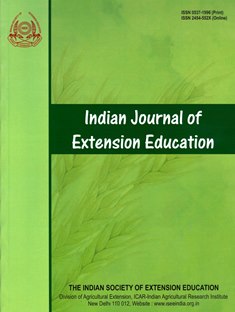Breaking the Barriers of Farm Income through Supplementary Enterprises: A Step beyond Farming Systems
DOI:
https://doi.org/10.48165/IJEE.2025.61204Keywords:
Household income, Secondary agriculture, Agri enterprises, Technology uptake, Propensity matchingAbstract
The study was conducted in ten districts of Karnataka in which Krishi Vigyan Kendras (KVKs) have introduced improved agricultural technologies and practices in selected villages during 2022. The interventions aimed at enabling the farmers to realize higher income from farm and non-farm activities. Propensity Score Matching was used to overcome the bias in sampling of treated and control category households. The probit analysis was applied to study the factors influencing household income. Agriculture + Horticulture + Livestock and Agriculture + Livestock were the most practiced farming systems by treatment and control group farmers, respectively. Increase in average net income was noticed in both the categories of the farmers over the benchmark. However, the highest net income was achieved by the treatment group farmers practicing Agriculture + Horticulture + Livestock + Supplementary enterprises. The importance of technological interventions was particularly evident when the same combination of enterprises practiced by the control category could only fetch lesser income.Downloads
References
Abate, T., Shiferaw, B., Gebeyehu, S., Amsalu, B., Negash, K., & Assefa, A. (2011). A systems and partnership approach to agricultural research for development: Lessons from Ethiopia. Outlook on Agriculture, 40(3), 213–220.http://dx.doi.org/10.5367/oa.2011. 0048
Basantaray, K., Acharya, S., & Patra, T. (2024). Crop diversification and income of agricultural households in India: an empirical analysis. Discover Agriculture, 2(1), 1-9.http://dx.doi.org/ 10.1007/s44279-024-00019-0
Bayissa, D. D. (2015). Investigating Key institutional factors affecting the linkage of knowledge institutes with farmers in agricultural research in Ethiopia. American Journal of Human Ecology, 4(2), 16-32.http://dx.doi.org/10.11634/216796221504701
Birthal, P. S., Negi, D. S., & Roy, D. (2017). Enhancing farmers’ income: who to target and how? Policy Paper-30, National Institute of Agricultural Economics and Policy Research New Delhi, India. https://niap.icar.gov.in/pdf/policy-paper/Policypaper 30.pdf
Chandre Gowda, M. J., Rana, R. K., Pal, P. P., Dubey, S. K., Kumar, A., Meena, M. S., Singh, R., Bordoloi, R., Bhaskaran, A., Raut, A. A., Rajesh, T., Kumar, B., & Thimmappa, K. (2023). Economic performance of enterprises promoted under ARYA and relationship with entrepreneurial competencies. Indian Journal of Extension. Education, 59(2), 10-15. http://doi.org/10.48165/ IJEE.2023.59203
Chandre Gowda, M. J., Venkatasubramanian, V., Rana, R. K., Singh, R., Singh, R. K., & Gautam, U. S. (2024). Technology application driven farmers’ income enhancement: Evidences for spatial, sectoral and social inclusiveness. Indian Journal of Agricultural Sciences, 94(3-Special Issue), 124-131.https://orcid.org/0000- 0001-9198-7426
Damba, O. T., Ansah, I. G. K., Donkoh, S. A., Alhassan, A., Mullins, G. R., Yussif, K., Taylor, M. S., Tetteh, B. K. D., & Appiah Twumasi, M. (2020). Effects of technology dissemination approaches on agricultural technology uptake and utilization in Northern Ghana. Technology in Society, 62, 101294. https:// doi.org/10.1016/j.techsoc.2020.101294
Fan, S., & Rue, C. (2020). The Role of Smallholder Farms in a Changing World. In S. Gomez y Paloma, L, Riesgo & K. Louhichi (Eds.), The Role of Smallholder Farms in Food and Nutrition Security (pp. 13-28). Springer, Cham. https://doi.org/10.1007/ 978-3-030-42148-9_2
Ghadim, A. K. A., & Pannell, D. J. (1999). A conceptual framework of adoption of an agricultural innovation. Agricultural Economics, 21, 145–154.https://doi.org/10.1016/S0169-5150 (99)00023-7
Government of India. (2018). Report of the committee on doubling farmers’ income. https://agriwelfare.gov.in/Documents/DFI%20 Volume%207.pdf
Government of India. (2024). Economic Survey 2023-24. https:// www.indiabudget.gov.in/economicsurvey/doc/eschapter/ epreface.pdf
Government of Karnataka. (2024). Economic Survey of Karnataka 2023-24. https://des.karnataka.gov.in/storage/pdf-files/ARC/ Economic_Survey_2023-24_FINALENGLISH.pdf
Greene, W. H. (2002). Econometric Analysis (fifth Ed.), Prentice Hall, Pearson Education. https://www.ctanujit.org/uploads/2/5/3/9/ 25393293/_econometric_analysis_by_greence.pdf
Gulati, A., & Juneja, R. (2022). Transforming Indian Agriculture. In R. Chand, P. Joshi, &S. Khadka (Eds.), Indian Agriculture Towards 2030 (pp. 9-37). India Studies in Business and Economics. Springer, Singapore. https://doi.org/10.1007/978-981- 19-0763-0_2
International Fund for Agricultural Development. (2009). Country Programme Evaluation, Federal Democratic Republic of Ethiopia. https://www.ifad.org/documents/38714182/39713017/ ethiopia.pdf/9e490422-4c34-4bc4-8597-569d0c3e2b65
Jatav, S. S. (2024). Livelihood diversification and rural household economic security in central and Bundelkhand regions of Uttar Pradesh, India. Indian Journal of Extension Education, 60(3), 07-11. https://doi.org/10.48165/IJEE.2024.60302
Kumar, A., Kumar A., & Kumari P. (2022). Income diversification: A way towards attracting rural youth in agriculture. Indian Journal
of Extension Education, 58(4), 107-112. https://epubs.icar.org.in/ index.php/IJEE/article/view/128447
Majhi, B., & Kumar, A. (2018). Changing cropping pattern in Indian agriculture. Journal of Economic and Social Development, 14(1), 37–45.
Mossie, W. A. (2022). The impact of climate-smart agriculture technology on productivity; Does row planting matter? Evidence from Southern Ethiopia. The Science World Journal, 2, 1-11. https://doi.org/10.1155/2022/3218287
Nain, M. S., Singh, R., Mishra, J. R., & Singh, A. K. (2024). Developing model for diffusion of farmers’ innovations for maximizing farm income: Indian Agricultural Research Institute Experiences, Indian Journal of Extension Education, 60(1), 105- 110. https://doi.org/10.48165/IJEE.2024.60120.
National Statistical Office. (2021). Situation assessment of agricultural households and land and livestock holdings of households in rural India, 2019. https://www.mospi.gov.in/sites/ default/files/publication_reports/Report_587m_0.pdf
Rajni, S. S., & Walia, S. S. (2016). Productivity and economics of improved interventions in existing farming system modules of Punjab. Indian Journal of Extension Education, 52(1&2), 117- 120. https://epubs.icar.org.in/index.php/IJEE/article/view/144165
Seemakowsar, N., & Gaddi, G. M. (2024). Analyzing the economic dynamics of farming systems in the central dry zone of Karnataka. The Mysore Journal of Agricultural Sciences, 58(2), 262-273. https://old.uasbangalore.edu.in/images/2024-2nd-Issue/ 25.pdf
Tesfaye, S., Bedada, B., & Mesay, Y. (2016). Impact of improved wheat technology adoption on productivity and income in Ethiopia. African Crop Science Journal, 24(1 supplementary), 127–135. https://doi.org/10.4314/acsj.v24i1.14S
Tiwari, U., Singh, A., Kumar, P., Venkatesh, P., Singh, R., Kumar, A., Bisen, J., & Kumar, H. V. H. (2023). Status and changes in composition of agricultural household’s income in India. Indian Journal of Extension Education, 59(1), 59–64. https:// epubs.icar.org.in/index.php/IJEE/article/view/131865
Toma, L., Barnes, A. P., Sutherland, L. A., Thomson, S., Burnett, F., & Mathews, K. (2018). Impact of information transfer on farmers’ uptake of innovative crop technologies: a structural equation model applied to survey data. Journal of Technology Transfer, 43(4), 864–881. https://link.springer.com/article/ 10.1007/s10961-016-9520-5
Vatta, K., & Budhiraja, P. (2020). Farmers’ income in India: trends and prospects for future growth. Agricultural Economics Research Review, 33(2), 177-189. http://dx.doi.org/10.5958/0974- 0279.2020.00030.0
World Bank. (2019). World development indicators. The World Bank.
Downloads
Published
Issue
Section
License

This work is licensed under a Creative Commons Attribution-NonCommercial-NoDerivatives 4.0 International License.

